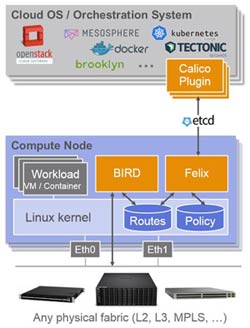As IT organizations move to embrace containers, many are revisiting the entire stack on which their IT services are delivered. After all, relying on legacy IT infrastructure to deliver modern applications seems counterintuitive. In place of that legacy infrastructure, IT organizations are looking at embracing everything from lighter-weight implementations of Linux such as Tectonic from CoreOS to virtual networks such as the open source Project Calico initiative.
With the arrival of version 1.1 of the Kubernetes orchestration framework, Project Calico can now be integrated with CoreOS alongside existing support for OpenStack and Mesosphere management. Sponsored by Metaswitch, Project Calico implements a virtual router in each compute node in a way that eliminates the need to rely on a virtual switch. Each vRouter propagates workload reachability information, also known as routes, to the rest of the data center using the Border Gateway Protocol (BGP).
Andy Randall, lead evangelist for Project Calico and senior vice president and general manager for Metaswitch, says the end goal is to significantly reduce the amount of physical infrastructure required to provide networking services in a world where commodity compute capacity in the form of industry standard x86 servers is readily available.

Naturally, the process is not going to take place over night. Substantial technical and cultural IT issues will need to be addressed. But as is often the case when it comes to enterprise IT, the most significant changes are the ones that take several years to play out before everybody starts to recognize just how profound they really are.



